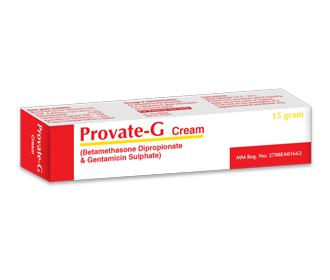
PROVATE G Cream
Therapeutic Class
Corticosteroids plus Antibiotics Ointment
Indications
For the relief of inflammatory manifestations of resistant or severe psoriasis and corticoid responsive dermatoses when complicated by secondary infections caused by organisms susceptible to Gentamicin including sensitive strains of streptococci (group A beta hemolytic, alpha hemolytic), Staphylococcus aureus (coagulase positive, coagulase negative and some penicillinase strains) and gram negative bacteria, Pseudomonas aeruginosa, Aerobacter aerogenes, Escherichia coli, Proteus vulgaris and Klebsiella pneumoniae or when the possibility of such infections is suspected. Such disorders include psoriasis, contact dermatitis, atopic dermatitis (infantile eczema, allergic dermatitis) neurodermatitis (lichen simplex chronicus), lichen planus, eczema (including nummular eczema, hand eczema, eczematous dermatitis), intertrigo, dyshidrosis (pomphalyx), seborrheic dermatitis, exfoliative dermatitis, solar dermatitis, stasis dermatitis and anogenital and senile pruritus. It is indicated for the topical relief of subacute/chronic hyperkeratotic and dry corticosteroid responsive dermatoses.
Chemical Composition
Each gram contains:
Betamethasone Dipropionate 0.64mg equivalent to 0.5mg Betamethasone & Gentamicin Sulphate 1.7 mg equivalent to 1mg Gentamicin.
Packaging
15g / tube
Dosage & Administration
For topical application only. Apply thin film to completely cover the affected area twice daily, once in the morning and at night. For some patients adequate maintenance therapy may be achieved with less frequent application.
Contraindications
Patients with a history of sensitivity reactions to betamethasone dipropionate, other corticosteroids, gentamicin sulphate or any components of Provate Cream & Provate-G Cream. Provate products are contraindicated in viral infections of the skin, such as vaccinia, varicella and herpes simplex, also tuberculosis, acne rosacea, fungal skin infections, perioral dermatitis and ulcerative conditions.
Side Effects
Most commonly mild to moderate burning, stinging, dry skin, pruritus and irritation. Other reactions with corticosteroids: Hypertrichosis, acneform eruptions, hypopigmentation, perioral dermatitis, allergic contact dermatitis, maceration of the skin, secondary infection, skin atrophy, striae and miliaria. Treatment with gentamicin has produced transient irritation (erythema and pruritus) that usually did not require discontinuance of treatment.

